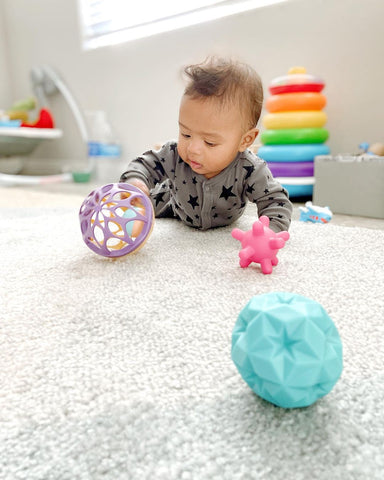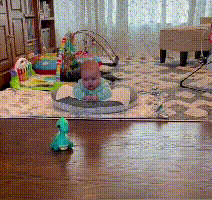Baby Tummy Time Tips and Tricks

Today, most parents know that placing babies on their backs to sleep in their first year is the safest position, which decreases the risk of sudden infant death syndrome (SIDS) by more than 50%. However, a baby needs time on his or her tummy for stretching and strengthening his back and neck muscles.
In this article, we’ll talk about what tummy time is, why it’s important, and 15 top tips for tummy time success.
What’s Tummy Time?
Tummy time, as the name implies, refers to time that your baby spends on their tummies. It is the activity of placing your newborn baby on its stomach when he’s awake and supervised, according to the American Academy of Pediatricians. Remember, "back to sleep, tummy to play": Your baby should always be awake during tummy time and under your careful watch.
Why is tummy time important?
If your baby doesn’t get the opportunity to play on their tummy, here’s some bad effect:
1. Positional Plagiocephaly
- Baby develops a flattening on the back or side of the head
- Baby’s soft skull bones constantly have pressure applied to them, which can lead to the soft bone flattening
- If it’s severe and left untreated, this can cause asymmetries of the head and face
2. Positional torticolis
- The muscles in baby’s neck become stiff or tight when baby spends all their time on their back or in equipment
- It can lead to a baby favouring one side of their body
3. Gross Motor Delays
- Baby were more likely achieving gross motor milestones like rolling over, crawling and sitting later than babies who spent time on their tummy.
Tummy time strengthens neck and upper body muscles, lower back muscles and hips and legs. It gives the opportunity to work on skills of rolling. It’s through tummy time that a baby learns to firstly shift their weight from one side to the other and then roll over. Practicing tummy time helps babies develop the muscles necessary to lift their heads and, eventually, to sit up, crawl and walk. Belly time while he is awake also helps him maintain a round head shape.
Tummy time has another benefit: babies love connecting with their parents, so when you’re right down on the floor with your beautiful baby, tummy time can be a great way to strengthen your bond as she strives and thrives to reach her first big physical milestones.

When Should I Do Tummy Time with My Newborn?
It ‘s recommended by The American Academy of Pediatrics (AAP) that tummy time should start as soon as your newborn comes home from the hospital. Start by placing her belly-down on your chest or across your lap 2-3 times each day for about 3-5 minutes each time and gradually increase tummy time as baby gets stronger and more comfortable. The best times to practice tummy time include when baby wakes up from a nap, after a diaper change, or after bath time, when you have their full attention.
How long should tummy time last?
In the beginning, newborn can start with a short period of time (3-5 minutes) 2-3 tummy time sessions daily. As your baby gets used to tummy time, you can increase the amount of time they spend in this position in order to encourage good muscle control in their necks. Gradually, increasing each tummy time session to 10 minutes, 4 to 5 times a day. By 4 months of age, he can be on his tummy a full hour.
When can I stop Tummy Time?
Once your baby begins to roll over front-to-back and back-to-front (around six months) and spends time on his stomach on his own, you can cut back on your tummy time routine. Around 7-9 month, your baby begins crawling, he will be getting the developmental benefits of Tummy Time while moving, and it is not as essential to have them do Tummy Time. However, you can still keep encouraging your little mover to spend plenty of time playing and exploring his world!

Top 15 Tips for Tummy Time Success
Tummy Time is an important part of your newborn's growth. The following are tips to make sure everything goes smoothly.
1. Start Young
As we have stated above, the sooner your baby start tummy time, the sooner they will be able to roll over and crawl. Also, the earlier you start the easier it can be for them to tolerate this position.
2. Trying several shorter stints a day
Tummy time is not as a marathon, you can’t expect your baby do it for a full hour right away. It can be two to three 3-minute sessions here and there throughout the day and gradually increase. Depending on your tolerance for your baby getting upset, you can decide how long to leave them.
3. Move All Pets In A Separate Room
Before you get your baby to have tummy time you need to get the area ready for them. You need to make sure it is not dirty, there is room for them to move. In case there can be a moment where your fur baby gets excited or scared and can go running for your baby, it's better to leave your cats and dogs in a different room.
4. Get down on the floor
Your baby needs a hard, sturdy surface to be able to work their muscles. The floor is an ideal spot. You need to make sure that you’re not trying to have tummy time on your bed. A soft surface like a bed can lead them to straining or hurting themselves.
5. Set-up a softspace and lay baby down
A blanket or a tummy time mat on a firm, flat surface works well. It can provide a nicer area for your baby to have tummy time and have them be more conformable. And placing a soft blanket down is going to be a better alternative than trying to do tummy time of a bed or sofa.

6. Lie on your bellyand/or lap
Tummy time on the floor might not be your baby’s thing for a while. If this is the case, you can use your own body(Chest, Belly, Lap, shoulder) as baby’s personal tummy time mat. Place baby across your lap, belly down. Use your hand to rub their back or offer gentle, rhythmic pats. You can also try laying down on your back and placing baby tummy down on your belly.
7. Use an Elevated Surface
Prop him up by placing a nursing pillow or a towel (or other firm cushion) under his chest and arms if he initially protests tummy time. Then try to wean him off of using these props. It makes it a little easier because they don’t have to work as hard against gravity as they do when they are flat on the ground.
8. Switching up the locations
If your baby hates tummy time, try to switch up the locations. A change in scenery is sometimes enough to keep tummy time tolerable.
9. Use special tummy time toys

Put out some toys that your baby can grab. Spread them around your little one in a circle so he’ll be tempted to reach for them. You can try rattles or squeaky toys that they can shake or squeeze. Some cute musical crawling toys for rummy time can also distract them from the task at hand, which helps develop all of the different muscles necessary to eventually sit up, crawl and walk.

10. Use a mirror

Put a plastic mirror in front of your baby so that they can see themselves. while your little one won’t know they’re looking at their own reflection, most babies get a kick out of peeking and laughing at the “other” baby in the mirror. It will encourage them to practice lifting their head and pushing up on their arms.

11. Get down on the ground with them

Get on the floor and get face to face with your little one. Talk, sing and play with your baby while they're on their tummy. They will be motivated to engage with you, and you can even practice having them track different toys/objects while lying with them in this position to get some neck rotation in as a bonus!
12. Massage

If you baby love it, massage can help them relax, distract and help them better enjoy the tummy time.
13. Encourage Older Siblings To Play With Them
Your baby might be feeling the pressure from you — plus a fresh face can make tummy time more interesting. Kids can get down on the floor more easily than adults, and they have more zip in their play when your baby needs an energy boost. Just be sure to keep a close watch on both kids.
14. Try a football hold
Football carry is great. This is a good beginner option for babies who resist any and all tummy time.Hold baby like a football, balancing their tummy on your arm with their legs and arms on either side. Be sure to support their back and neck with your other hand.
15. Supervise baby during tummy time
As he gets stronger and starts moving more, clear away dangerous things. Never leave an infant unattended on his belly as he could get into a position that is dangerous and suffocate
Recommend Articles:
Tummy time for babies: in pictures
Tummy Time Milestones For Babies
Toys That You Need For Your Baby's Tummy Time
|
Baby Play Mat
|

|
BUY AT AMAZON |
| Sensory Balls |
 |
BUY AT AMAZON |
| Baby Stimulation Cards |  |
BUY AT AMAZON |
| Dino Crawling Toys |  |
BUY AT AMAZON |
| Hip Hop Duck |  |
BUY AT AMAZON |
| Muscial Press & Go Toy |  |
BUY AT AMAZON |
| Folding Touch Feel Books |  |
BUY AT AMAZON |
